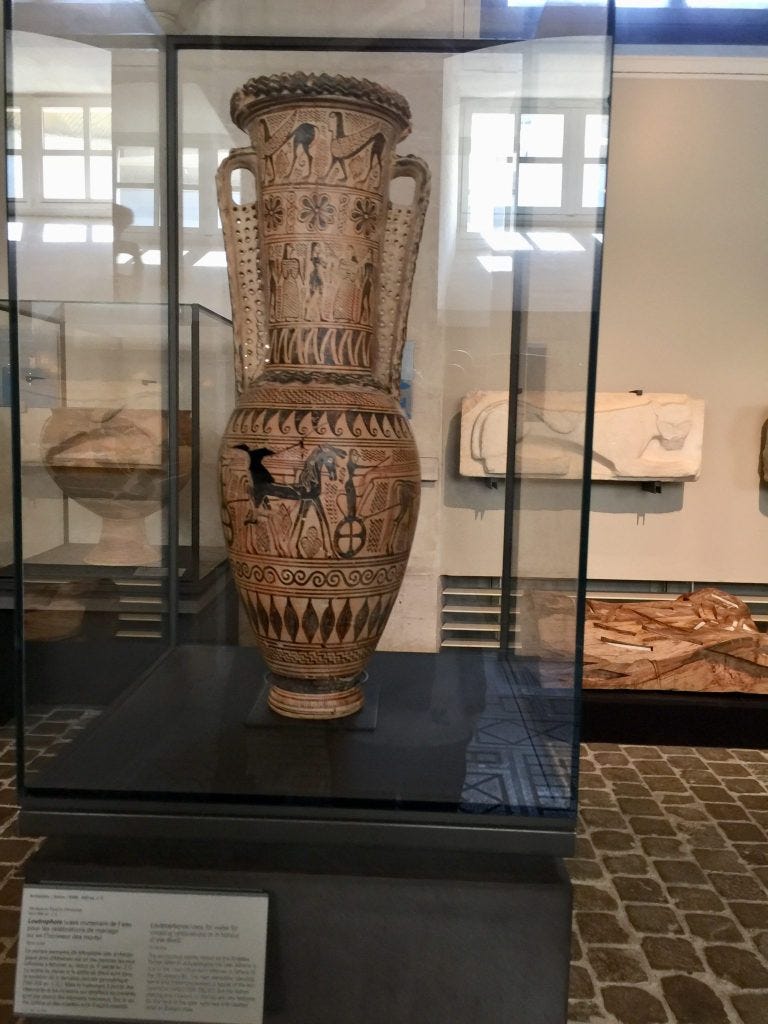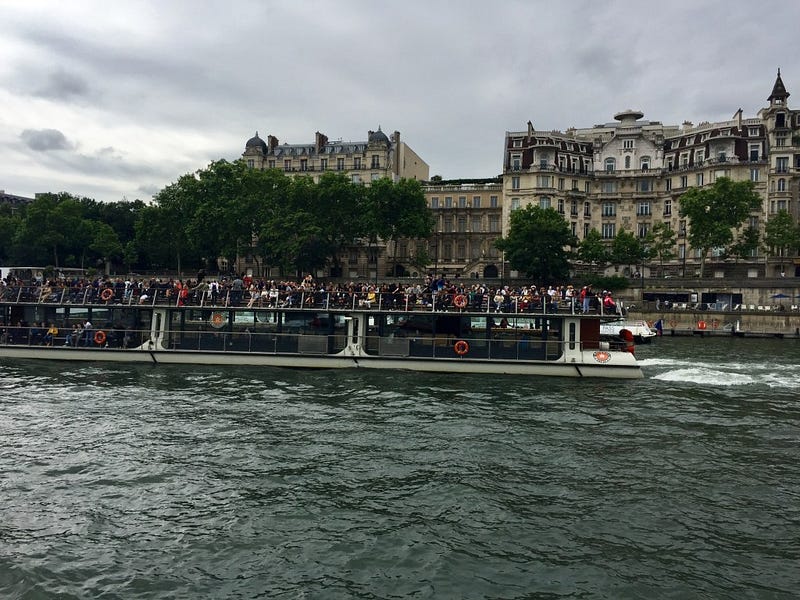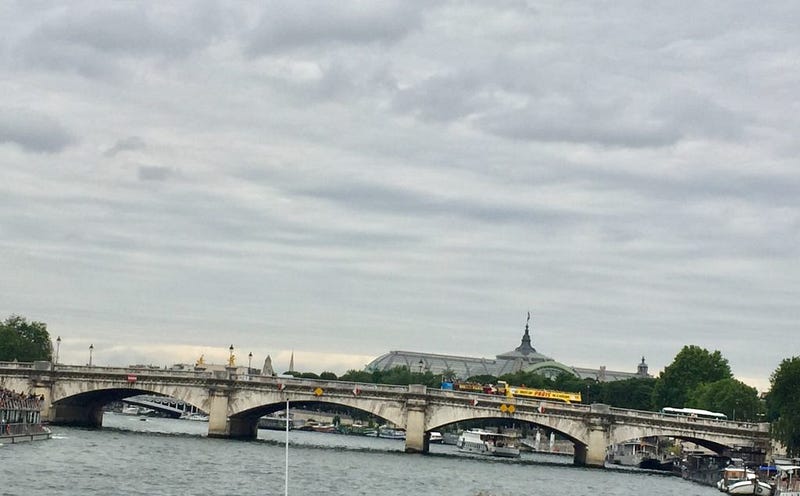Louvre is the largest art museum globally in terms of area (72,735 sq. mt.) and second-largest in terms of art collection (the largest art collection is in Hermitage Museum in Saint Petersburg, Russia).
Louvre has over 35,000 works of art, which are displayed in about 16 kilometers of galleries. Even if you spent three seconds looking at each work of art, it would take you three months to see everything in the museum.
We had put aside a full day for Louvre, having no idea that it will take us half a day to get inside. The line was a mile long from the front entrance through the glass prism in the complex compound.
Luckily Louvre has a second entrance that many people don’t know about. It is through the underground shopping center. The line was much shorter there, but it still took us an hour to get inside when we got through the security.
To our dismay, we had to line again—this time to buy the tickets.
By the time we got in, it was one pm.
Lucky for us, it was Friday. On Fridays, the museum is open till ten pm.
We spent seven hours inside.

I was more impressed with the history and architect of the building than the thousands of artwork it was housing.
The museum has one whole section devoted to the history and architecture of the Louvre. It starts with the old castle walls, which are well preserved in the underground portion of the museum.
Louvre was originally built as a fortress in the 12th century to protect Paris. Then, in the 16th century, it was reconstructed to serve as a royal palace. After that, it was built and rebuilt many times. Nearly every monarch expanded it.
I was particularly impressed by the art on the ceilings.



In 1682, Louis XIV moved the royal residence to Versailles, and the Louvre became home to various art academies, offering regular exhibitions of its members’ works.
In 1793, after the French Revolution, the National Assembly opened Louvre as a museum with 537 paintings. But it had to be closed in 1796 due to structural problems with the building. Napoleon Bonaparte opened the museum in 1801 and expanded the collection.
It was Napoleon who created the foundations for the world-famous museum it is today. He enlarged its collection by bringing art from his military campaigns, private donations, and commissions he made.
In 1815, when Napoleon abdicated with the Treaty of Fontainebleau, almost 5,000 artworks were returned to their countries of origin. France was allowed to keep only a few hundred works. Since then, the collection had been enhanced many folds.
We started with Egyptian, Greek, and Roman antiquities and Islamic Art Section.



I wanted to learn more about the objects I was seeing. There was a minimal description on the plaques beside the artifacts. We had rented the audio-guides, but they were frustrating. They didn’t work logically. We stopped fiddling with them and just watched the objects without bothering to learn about them.
In a museum bookshop, I spotted a book that had images of all the key objects on display along with their description. I wanted to buy the book, but my husband refused.
He wanted me to buy it on the way back from the museum or online when we get back home. His rationale was that we would be carrying the book all day with us. I wanted to buy it from the museum store to learn about what I was watching and to enjoy the museum. Reluctantly I agreed.
But imagine my anger when we discovered that the book was sold only in the museum and was not available in any bookstore or online.
But the upside of the whole experience was that I made my husband promise me that, in the future, he will never stop me from buying anything. (Not a bad outcome if you ask me.)
Visting Mona Lisa
By the time we got to paintings galleries, we were pretty tired. But we were rejuvenated when we passed through the majestic galleries with massive paintings by old masters. An hour later, we got in line to see Mona Lisa.
Without question, the Louvre’s most famous work is Leonardo da Vinci’s, Mona Lisa.
It has a whole room to itself.
At least five security guards were managing the crowds. The barricades were keeping the crowds at least two meters away from the painting.
The painting itself was small — only 21 by 30 inches. And it was covered with bullet-proof glass. In 1911, it got stolen. But was recovered two years later.
Most of the people were not interested in the painting but taking their photographs with it. I have never seen such weird selfie-poses in my life.

To me, Mona Lisa was faded and lusterless.
The famous enigmatic smile was non-existent.
There were many more impressive paintings in the gallery than Mona Lisa, but most people just ignored them.
I particularly liked four paintings of Hercules in the large gallery just outside the Mona Lisa’s room, in which the legendary mythical character was shown fighting different demons.
What I liked the most in the whole museum was the statue of Venus de Milo, one of the most famous ancient Greek sculptures.
It was said to be discovered by a peasant named Yorgos Kentrotas in 1820, inside a buried niche within the ancient city ruins of Milos.
Created sometime between 130 and 100 BC, the statue is believed to depict Aphrodite, the Greek goddess of love and beauty.
It is a marble sculpture, slightly larger than life-size at 203 cm (6 ft 8 in) high. Its arms have been missing since its discovery.



The last area we visited was the two exhibition spaces that housed the 18th and 19th-century sculpture collections.
These galleries are under the prism and receive a lot of daylight. They were built as part of the Grand Louvre project and were inaugurated in 1993 and 1994.


We spent seven hours inside. I hope you enjoyed my account of the Louvre.
The next post is about another equally impressive museum (nee palace).
Photo by redcharlie on Unsplash










































































